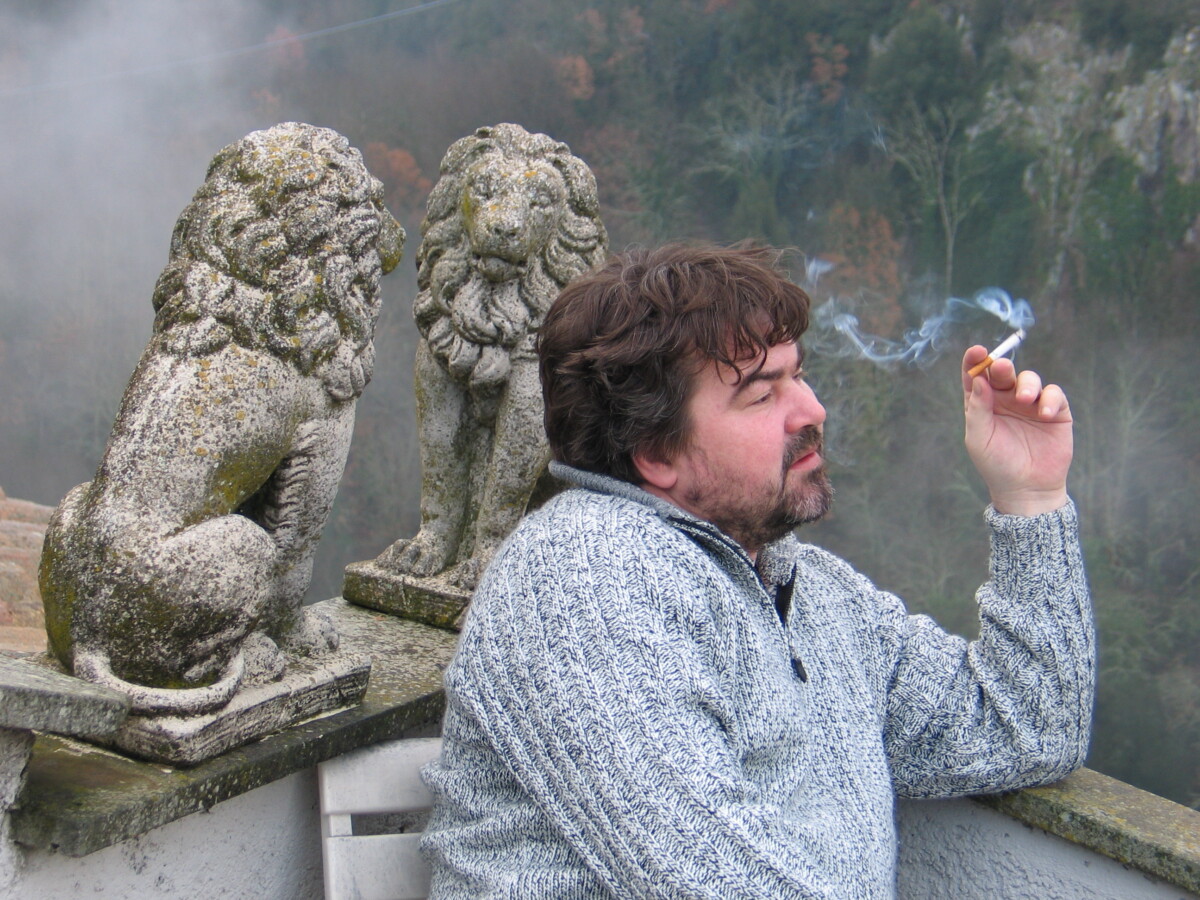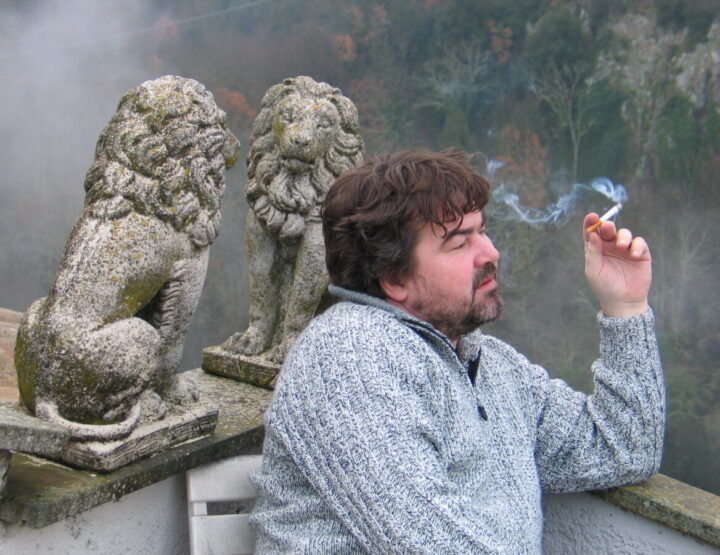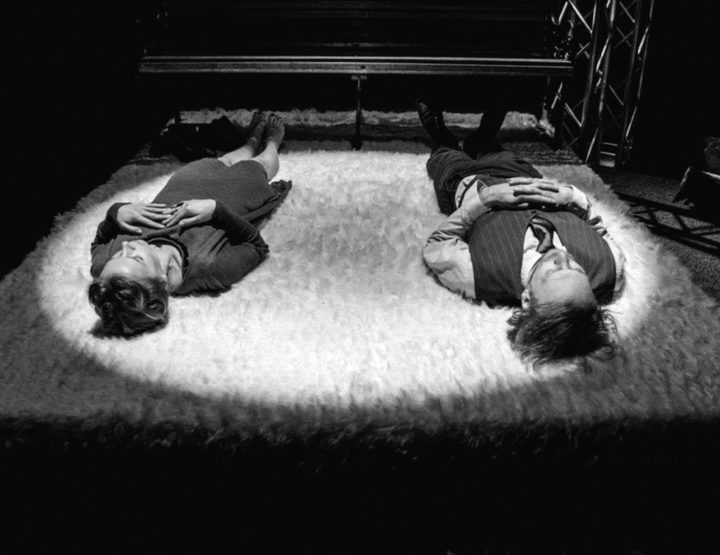It is not at all easy to make generalisations about the work of Mart Kivastik (1963). With the very first sentence he usually takes the reader right into the midst of life, into the focus of events. His writing often even lacks introduction, let alone any theorising, interpretations and summaries by the narrator. The simplicity, however, is deceptive. Besides excellent narrative skills, Kivastik certainly has his own vision of man’s role in our contemporary world. Regarding his whole oeuvre, its disillusionment is grimmer than the harsh, but nevertheless warm, reality of his individual stories.
The writer’s environment is often the unimposing reality of the slum and the characters are simple people, with their straightforward pettiness and their honour. Besides other qualities, their stupidity is not concealed either, although the characters are depicted with warmth. The stories of Kivastik do not bother us with artificial woes or anxieties born out of culture as such. His heroes are, instead, relatively innocent and unspoilt by complexities of civilisation. They still harbour a naïve yearning for distant places, idealism, faith in values and principles, however unrealistic or downright primitive they may be. Essential hope never quite dies in his characters, although they are unable to efficiently face changes in life.
This is how the reader sees Kivastik in his first book, Homme (Tomorrow, 1993). Here is revealed one of the charms of the writer’s everyday realism – his fondness for small and often trivial memory pictures and nostalgia. Kivastik has no Proustian ambitions, nor does he project a refined Oedipus. His characters remember insignificant mundane episodes, and the old men (fathers) simply get on everybody’s nerves and mess up their brains. In depicting the Brezhnev-era childhood of today’s middle-aged, Kivastik is truly superb, presenting a variety of witty themes and incidents, which are easily recognised by a whole generation: for example, cigarettes and cheap wine, which seem surrogates in the modern capitalist world; or how you tried to phone your girlfriend, after setting Procol Harum at full blast in your tiny council flat, with paper-thin walls that easily carried even the sound of little mice – just to produce an impression of yourself as a really cool chap with a liberated and carefree lifestyle. Still, Brooker had hardly started when your neighbours and your father turned against you, and the vinyl record, borrowed from fast-fisted tough guys and costing half your parents’ monthly salary, got a serious scratch in it.
Under such circumstances people craved not only Led Zeppelin and Jim Morrison, but also Marc Bolan, Sweet and Slade. With great excitement and fervour, perhaps never experienced in the free world (to say nothing of the contemporary world), to such an extent, in a yearning for musical idols. Pleasure starts with setting limits, and the materially ascetic stagnation-era childhood was therefore everything but a priori misfortune. With great skill and a touch of nostalgia, Kivastik has managed to capture the colours of that time. He not only describes young boys who tore the skin off their fingers while practising the opening chords of Smoke on the Water and drank their first cheap wine (the short story 1979, the play Peeter and Tõnu), but also life in the communal flat and kitchen shared by Soviet-type women and those with memories of grander times in the 1920s and 1930s. Elderly Estonian female critics have certainly recognised something familiar in Kivastik’s stories (prose and drama versions of Õnne Leena) etc.
Tomorrow is essentially a nostalgic book about the Soviet era. It is about a time when external ideals were alien to most people, who instead clung to their inner ideals, dreams and hopes. Kivastik loses much of this idealism in his next book of three longer stories, Palun õnnelikuks (Make Me Happy, Please, 1996). As for fluency of form, this is an experiment in magical realism, which is perhaps not instantly captivating, where a mundane story is mixed with ancient Estonian myths, boyish and masculine idealist dreams, and also allusions to the idealistic basic texts of Occidental culture (Shakespeare, Dumas, Flaubert). The author nevertheless produces a readable text with a relatively complicated inter-textual field. Although the narrative style of Make Me Happy, Please remains grotesque throughout, the book, dedicated to the author’s mother, vividly points out the gaps between romantic book ideals and daily existence, being as such a sort of key to the entire oeuvre of Kivastik.
The book Make Me Happy, Please introduces the topic of the ‘freezing artist’, which in several variations is further developed in many later works. For example the book Presidendi lapsed (The President’s Children, 2001) presents portraits of bohemians who more often than not exist in life’s marginal regions; the longer story Varblane (Sparrow, 1999) with elements of science fiction, but a clearly recognisable prototype in the Estonian context, plus plays and newspaper articles. Problems connected with the vulnerable ego of an artist are presented rather stereotypically. The description in several stories of working as a ticket inspector on the Tallinn-Tartu diesel train, are genuinely witty. This kind of job might well hide some sort of romantic mysteriousness and a desire for a loser-bohemian way of life to continue. In the context of the first half of the 1990s, this vision certainly does not lack a masochistic element – to work as a harassing devil on the weekly main route of those who have managed to fully retain their freedom and bohemian spirit.
More significant in these works than repeating the standard images attached to the artist since the romantic era is helplessness, caused by the inability to understand why it is that after having grown up in the spirit of musketeer ideals, knightly nobleness and poetic idealism, there is so much selfish, calculating superficiality and general loutishness around us every day. Even when Kivastik’s heroes have been enlightened or have indeed become intellectuals, their lives in the success-geared society still proceed rather pointlessly in miserable bohemian hovels, where sophistication is not necessary. The atmosphere of Kivastik’s artist stories has been shaped by an educated, but nevertheless provincial, town and its bohemian circle of people, the members of which often lag behind in the progress of life, or worse, are caught between the wheels of life, although they are by no means rubbish-bin people. Many of Kivastik’s heroes are familiar to the entire Estonian society. Quite a few of them, however, seem to walk in the gutter in comparison with today’s desirable canons.
Estonian critics have often called Kivastik’s atmosphere Beckett-esque. This is, however, misleading in many ways, caused primarily by the fact that Kivastik’s heroes are often solitary, marginal mavericks and become even more so on a theatre stage, as do Beckett’s. The dialogue ‘Why do you stay with me /Why do you keep me /There’s no one else /There’s nowhere else…’ from Beckett’s Endgame would indeed suit many a Kivastik character. But this kind of metaphysical anxiety (‘the same questions all through life, and the same answers’) and the problem of being forsaken by God, ascribed to Beckett by typical reviews, do not figure largely in Kivastik. The latter’s world is more like an upside-down Waiting for Godot, where Godot is brought onto the stage and revealed as exactly the same kind of ‘asshole as the rest of us’. Such a power of abstraction is much in evidence in one of his best plays, The Servant. The relations between three friends here illustrate the truth that a king is a king, not because he possesses some special and extraordinary royal qualities, but because others treat him as a king. Despite the seemingly marginal topic and characters, the play brilliantly resonates in an era in which our cynical mentality reigns supreme, where we know and understand perfectly well that most of what excites our attention and desires, what is in, is in fact nothing but any old bullshit. But we still want it.
The other stories by Kivastik also display the sad inevitability that if anyone manages to break out of his innocence and childhood, marked with naïve dreams and ideals, and abandons slums for intellectual life, he can expect nothing but emptiness, discord and pain unless he accepts the rituals of an idiot and adopts the soul of a yob. Kivastik is not actually turning his nose up at this kind of world (or not much). Although his latest collection of short stories, kui sa mind ei armasta, ära mine ära (if you don’t love me do not leave, 2003) is partly characterised by naturalistic pictures that scream out for social-critical help, what dominates in the end is a warm, funny, melancholy and slightly comforting sympathy with those who are not utterly enticed by the daily commands of our pragmatic success society. In a sense, the impact of Kivastik’s texts does not much differ from classical 19th century realism, which criticised the bourgeoisie. By means of naturalistic and psychological pictures of everyday life, such realism describes the life, sorrows and solitude, but also the humanity and particular greatness, of those cast aside or left out of the prevailing social code.
Kivastik himself, however, has not been an outsider nailed to the slums of provincial towns and bohemian hovels for years. His short stories and plays have received awards from public and critical juries. His dramas seem to have found their way to the best Estonian actors and big stages. How, and whether, this changes Kivastik’s identity, and whether the inevitable element of craftsmanship associated with increasingly frequent commissions will replace his urge to say things and the longing of his heart, is something that only time will tell.
© ELM no 22, spring 2006




